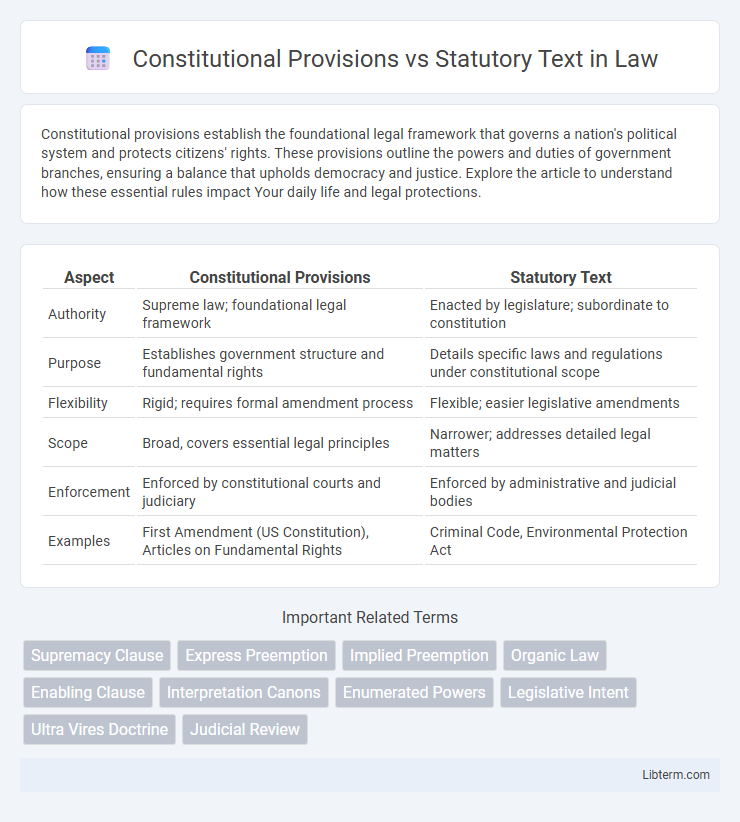Constitutional provisions establish the foundational legal framework that governs a nation's political system and protects citizens' rights. These provisions outline the powers and duties of government branches, ensuring a balance that upholds democracy and justice. Explore the article to understand how these essential rules impact Your daily life and legal protections.
Table of Comparison
| Aspect | Constitutional Provisions | Statutory Text |
|---|---|---|
| Authority | Supreme law; foundational legal framework | Enacted by legislature; subordinate to constitution |
| Purpose | Establishes government structure and fundamental rights | Details specific laws and regulations under constitutional scope |
| Flexibility | Rigid; requires formal amendment process | Flexible; easier legislative amendments |
| Scope | Broad, covers essential legal principles | Narrower; addresses detailed legal matters |
| Enforcement | Enforced by constitutional courts and judiciary | Enforced by administrative and judicial bodies |
| Examples | First Amendment (US Constitution), Articles on Fundamental Rights | Criminal Code, Environmental Protection Act |
Introduction: Defining Constitutional Provisions and Statutory Text
Constitutional provisions are the fundamental principles and established precedents that form the foundation of a nation's legal system, typically enshrined in a constitution. Statutory text refers to laws formally enacted by a legislative body, providing detailed regulations and rules that operationalize constitutional mandates. These two legal sources serve distinct roles, with constitutional provisions outlining broad governmental structures and rights, while statutory texts address specific legislative requirements.
Historical Evolution of Constitutional and Statutory Law
The historical evolution of constitutional and statutory law reflects the foundational framework of legal systems, where constitutional provisions establish fundamental principles and governmental structure, while statutory texts provide detailed regulations enacted by legislative bodies. Constitutional provisions often emerged from pivotal historical documents such as the Magna Carta and the U.S. Constitution, setting enduring legal standards and rights. Statutory laws evolved over time to address specific societal needs, allowing legislatures to adapt legal rules dynamically within the broader constitutional framework.
Sources of Authority: Constitution vs. Legislation
Constitutional provisions derive their authority directly from the constitution, establishing the fundamental legal framework and supreme law of a jurisdiction. Statutory texts are created by legislative bodies and derive their power from statutes enacted under the constitutional authority. The constitution serves as the ultimate source of legal authority, while legislation must comply with constitutional limitations and principles.
Structural Differences: Permanence and Flexibility
Constitutional provisions are characterized by their permanence, serving as the foundational legal framework that requires rigorous procedures for amendment, ensuring long-term stability and protection of fundamental rights. Statutory text, in contrast, offers greater flexibility, allowing legislators to modify laws more easily to respond to changing social, economic, and political conditions. This structural difference highlights the constitution's role as a stable, overarching authority, while statutory laws function as adaptable rules tailored for practical governance.
Interpretive Approaches: Judicial Perspectives
Judicial perspectives on constitutional provisions versus statutory text emphasize textual fidelity, where courts analyze original language and framers' intent to maintain constitutional supremacy. Interpretive approaches often involve balancing strict constructionism with purposive interpretation to resolve ambiguities in statutory text while upholding constitutional mandates. Case law demonstrates how courts prioritize constitutional principles when statutory provisions conflict, ensuring legal coherence and protection of fundamental rights.
Hierarchy and Supremacy in Legal Systems
Constitutional provisions serve as the supreme law within legal systems, establishing fundamental principles that supersede all statutory texts enacted by legislative bodies. Statutory texts must conform to constitutional mandates; any conflicting statutes are subject to invalidation through judicial review to maintain the hierarchy of laws. This supremacy ensures a coherent legal framework where constitutional norms guide legislative actions and safeguard individual rights against contradictory laws.
Amending Process: Constitutional Amendments vs. Statutory Revisions
Constitutional amendments require a rigorous, multi-step process often involving supermajority approvals in the legislature and ratification by states or referendum, ensuring broad consensus before changes take effect. Statutory revisions, by contrast, follow a simpler legislative process that typically involves standard majority votes within the legislative body without the need for public ratification. The heightened procedural safeguards for constitutional amendments protect foundational legal principles, while statutory revisions allow for more flexible and timely legal updates.
Conflicts and Harmonization: Resolving Legal Disputes
Conflicts between constitutional provisions and statutory text arise when laws enacted by legislature contradict the fundamental principles enshrined in a country's constitution, necessitating judicial scrutiny. Courts employ principles of constitutional supremacy to invalidate or reinterpret statutory provisions that violate constitutional mandates, ensuring harmonization of legal norms. Judicial review serves as the primary mechanism to resolve these disputes by aligning statutes with constitutional intent and preserving the rule of law.
Impact on Individual Rights and Liberties
Constitutional provisions establish fundamental rights and liberties that serve as the supreme legal standard, safeguarding individuals against government overreach and ensuring enduring protections. Statutory texts, enacted by legislative bodies, detail specific regulations and policies that can expand, modify, or limit those rights within constitutional boundaries. The interplay between constitutional mandates and statutory laws critically shapes the practical scope and enforcement of individual freedoms in society.
Practical Implications for Policymakers and Courts
Constitutional provisions provide the foundational legal framework that limits and guides statutory text, ensuring laws align with fundamental rights and principles. Policymakers must navigate these provisions carefully to draft statutes that withstand judicial scrutiny and uphold constitutional mandates. Courts interpret statutory text through the lens of constitutional provisions, resolving conflicts by prioritizing constitutional supremacy while balancing legislative intent with practical governance needs.
Constitutional Provisions Infographic

 libterm.com
libterm.com